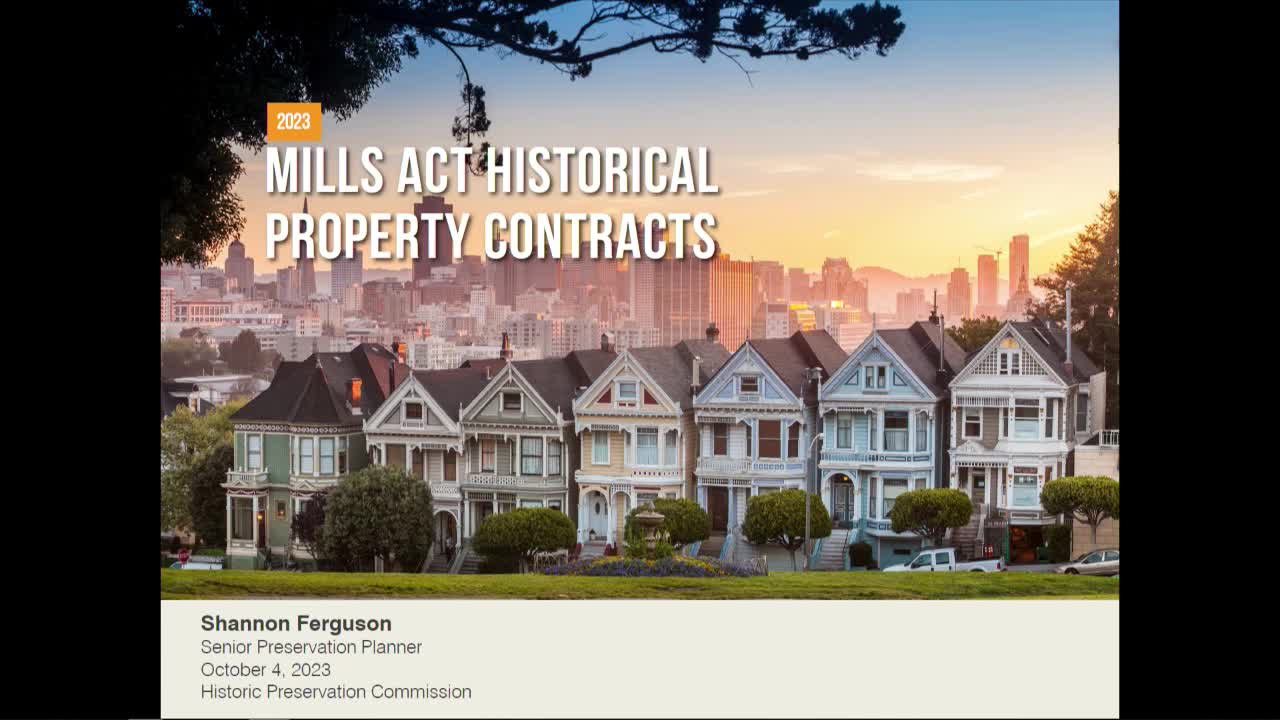Historic Preservation Commission recommends Mills Act contracts for three San Francisco properties
October 04, 2023 | San Francisco City, San Francisco County, California
This article was created by AI summarizing key points discussed. AI makes mistakes, so for full details and context, please refer to the video of the full meeting. Please report any errors so we can fix them. Report an error »

The San Francisco Historic Preservation Commission convened to discuss three significant Mills Act applications aimed at preserving historic properties in the city. The meeting highlighted the proposed rehabilitation plans for each property, which are designed to maintain their historical integrity while providing financial incentives through property tax savings.
The first property under consideration is located at 148-152 Fillmore Street, a Queen Anne style building constructed around 1900. The proposed rehabilitation plan includes extensive work such as bolting the foundation, repairing the siding, and replacing the roof, with an estimated cost of $225,000. The property owner is expected to save approximately $14,184 in property taxes during the first year, reflecting a 59.4% reduction from its assessed value.
Next, the commission reviewed the application for 988 Market Street, an eight-story office building designed in the Renaissance Revival style and built in 1922. The rehabilitation plan, estimated at $576,259, focuses on restoring the historic terracotta facades and other architectural features. The property owner anticipates a first-year tax savings of $176,681, a 69.19% reduction from the base year value.
Lastly, the property at 2209 Webster Street, an Italianate style single-family dwelling rebuilt circa 1900, was discussed. The proposed rehabilitation work, costing around $238,000, includes roof replacement and repairs to windows and siding. The owner is projected to receive $17,000 in property tax savings, representing a 70% reduction.
All three properties meet key criteria for the Mills Act, including necessity, investment, and distinctiveness. The commission staff recommended approval of the applications, emphasizing that the proposed rehabilitation and maintenance plans align with the Secretary of the Interior Standards for Rehabilitation.
The meeting concluded with property owners present to address the commission, underscoring the community's commitment to preserving San Francisco's rich architectural heritage. The next steps involve the Board of Supervisors reviewing the recommendations for final approval.
The first property under consideration is located at 148-152 Fillmore Street, a Queen Anne style building constructed around 1900. The proposed rehabilitation plan includes extensive work such as bolting the foundation, repairing the siding, and replacing the roof, with an estimated cost of $225,000. The property owner is expected to save approximately $14,184 in property taxes during the first year, reflecting a 59.4% reduction from its assessed value.
Next, the commission reviewed the application for 988 Market Street, an eight-story office building designed in the Renaissance Revival style and built in 1922. The rehabilitation plan, estimated at $576,259, focuses on restoring the historic terracotta facades and other architectural features. The property owner anticipates a first-year tax savings of $176,681, a 69.19% reduction from the base year value.
Lastly, the property at 2209 Webster Street, an Italianate style single-family dwelling rebuilt circa 1900, was discussed. The proposed rehabilitation work, costing around $238,000, includes roof replacement and repairs to windows and siding. The owner is projected to receive $17,000 in property tax savings, representing a 70% reduction.
All three properties meet key criteria for the Mills Act, including necessity, investment, and distinctiveness. The commission staff recommended approval of the applications, emphasizing that the proposed rehabilitation and maintenance plans align with the Secretary of the Interior Standards for Rehabilitation.
The meeting concluded with property owners present to address the commission, underscoring the community's commitment to preserving San Francisco's rich architectural heritage. The next steps involve the Board of Supervisors reviewing the recommendations for final approval.
Don't Miss a Word: See the Full Meeting!
Go beyond summaries. Unlock every video, transcript, and key insight with a Founder Membership.
✓
Get instant access to full meeting videos
✓
Search and clip any phrase from complete transcripts
✓
Receive AI-powered summaries & custom alerts
✓
Enjoy lifetime, unrestricted access to government data
30-day money-back guarantee

